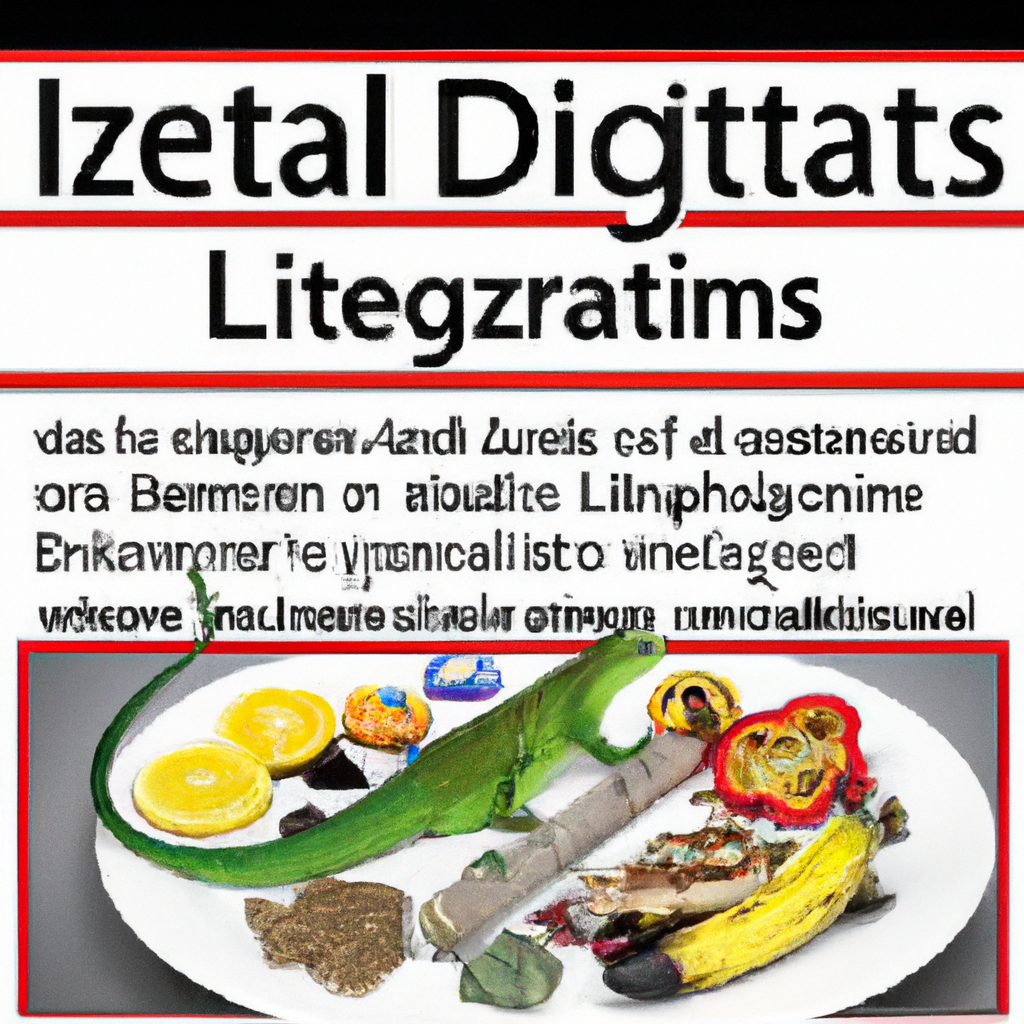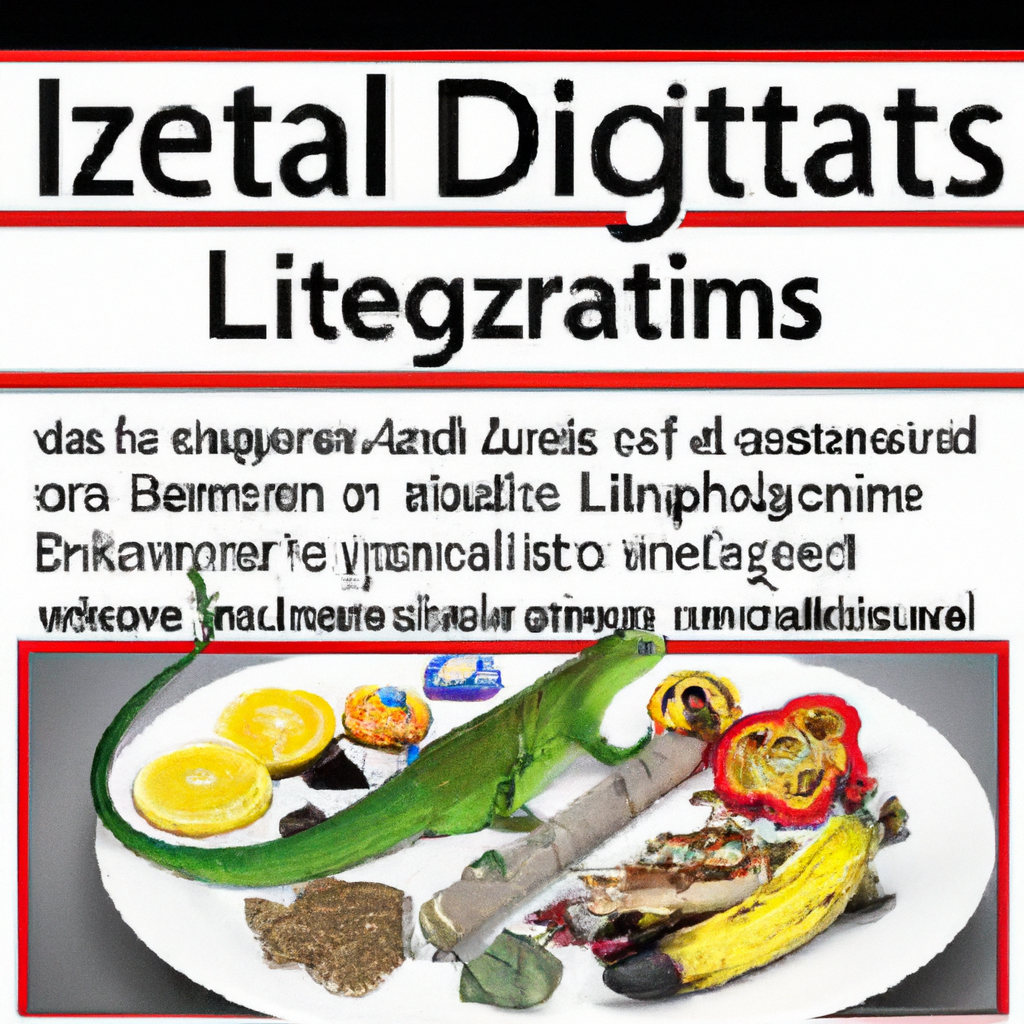Are you a proud owner of a pet lizard? If so, you know that taking care of these captivating creatures requires special attention, especially when it comes to their diet. In this article, we will explore the fascinating world of “Dietas Para Lagartijas,” or diets for lizards in English, and discover the best food options to keep your scaly companion healthy and happy. From mealworms to leafy greens, we’ll guide you through the essential elements of a well-balanced lizard diet, ensuring your reptile friend thrives in their natural habitat. So get ready to embark on an exciting journey into the world of lizard nutrition!
Types of Lizards
Desert Lizards
Desert lizards are a fascinating group of reptiles well-adapted to the harsh conditions of arid environments. Some popular desert lizard species include the Fringed-toed Lizard and the Horned Lizard. These lizards obtain most of their hydration from the food they eat and the retained moisture in their bodies. Their diet mainly consists of insects and small invertebrates found in their sandy habitats.
Tropical Lizards
Tropical lizards thrive in the humid and warm climates of rainforests and other tropical regions. Some examples of tropical lizards are the Green Anole and the Tokay Gecko. These lizards have a diverse diet, including insects, fruits, small vertebrates, and even nectar from flowers. It is important to replicate their natural diet when feeding them in captivity to ensure their optimal health.
Grassland Lizards
Grassland lizards, as the name suggests, inhabit open grassy areas. Common grassland lizard species include the Fence Lizard and the Blue-Tailed Skink. Their diet consists primarily of insects, such as grasshoppers and beetles, that can be easily found in their natural habitat. Providing a variety of insects is crucial for these lizards’ health and well-being.
Aquatic Lizards
Aquatic lizards, including the Green Anole and Water Dragon, have unique dietary needs due to their semi-aquatic lifestyle. These lizards consume a combination of aquatic plants, insects, small fish, and crustaceans. Providing a suitable habitat with access to water and a diverse diet is essential for the overall health and happiness of these aquatic reptiles.
Nutritional Requirements
Protein
Protein is a crucial component of a lizard’s diet. It aids in muscle growth, tissue repair, and overall development. Insects, small vertebrates, and commercially available reptile foods are excellent sources of protein for lizards. It is important to vary the protein sources to ensure a balanced diet.
Carbohydrates
While carbohydrates are not as essential for lizards as they are for mammals, they still play a role in providing energy. Carbohydrates can be found in certain fruits and vegetables, such as leafy greens, sweet potatoes, and carrots. However, it is crucial to feed carbohydrates in moderation, as overconsumption can lead to obesity and other health issues.
Fat
Lizards require a moderate amount of healthy fats in their diet for energy and to support various bodily functions. In the wild, lizards obtain fats from insects and small vertebrates. Feeding a variety of prey items and using nutritional supplements can ensure they receive adequate fat intake.
Vitamins
Vitamins are essential for lizards to maintain proper metabolic function and overall well-being. They need a variety of vitamins, including vitamin A, B complex vitamins, and vitamin C. These vitamins can be obtained through a balanced diet consisting of diverse prey items and fruits.
Minerals
Minerals, such as calcium and phosphorus, are vital for maintaining a lizard’s skeletal health. Calcium, in particular, is crucial for proper bone formation and preventing metabolic bone disease. Dusting prey items with calcium supplements before feeding can help ensure these reptiles receive the necessary minerals in their diet.

Feeding Methods
Live Prey
Feeding lizards live prey is a popular and natural method of providing them with a varied and stimulating diet. Insects like crickets, mealworms, and dubia roaches can be offered live to lizards, simulating their natural hunting instincts. It is important to ensure that the prey is an appropriate size and species for your lizard’s health and safety.
Pre-killed Prey
For some lizards, especially those that may be reluctant to eat or are too small to consume larger live prey, pre-killed prey can be a suitable option. This method involves offering dead insects or small vertebrates to the lizard. This eliminates any risk of injury from live prey and still provides the necessary nutrition.
Commercial Diets
Commercially available diets formulated specifically for lizards can be a convenient option for owners. These diets are often nutritionally complete and balanced, providing a blend of proteins, carbohydrates, and vitamins. However, it is important to read the labels and choose high-quality products designed specifically for the species of lizard you own.
Dietary Supplements
Calcium
Calcium is one of the most critical dietary supplements for lizards. It is necessary for proper bone development and muscle function. Providing a calcium supplement, either by dusting prey items or using calcium powder mixed into the food, ensures that your lizard receives adequate calcium levels.
Vitamin D3
Vitamin D3 is essential for lizards to metabolize calcium properly. It helps in the absorption and utilization of calcium, ensuring healthy bones and overall well-being. However, remember not to exceed the recommended dosage, as excessive vitamin D3 can have adverse effects on your lizard’s health.
Multivitamins
Multivitamin supplements can provide a broad range of essential vitamins and minerals to support your lizard’s overall health. These supplements are especially beneficial for lizards that have a limited variety of prey items available or those that are fed primarily commercial diets. Consult with a reptile veterinarian to determine the appropriate dosage and frequency for your specific lizard species.

Hydration Needs
Water Dish
Providing a water dish is essential for lizards to stay hydrated. Clean, fresh water should be made available at all times. Some lizards, especially those from arid environments, may not drink from a dish and obtain most of their hydration from the food they consume.
Misting
For lizards that require higher humidity levels or have specific hydration needs, misting can be an effective method. Use a spray bottle to mist the lizard’s enclosure, creating a fine mist of water droplets. This mimics natural rainfall and encourages lizards to drink from water droplets on leaves or surfaces.
Feeding Schedule
Juvenile Lizards
Juvenile lizards have a higher metabolic rate and therefore require more frequent feedings compared to adults. Feed young lizards daily or every other day to provide them with the necessary nutrients for growth and development. Varying the prey items and providing a balanced diet is crucial during this stage.
Adult Lizards
Adult lizards have slower metabolic rates and can be fed on a less frequent schedule. Typically, feeding adult lizards once every two to three days is sufficient. However, it is essential to monitor their body condition and adjust the feeding schedule as needed to maintain a healthy weight.

Special Dietary Considerations
Breeding Females
Breeding females have increased nutritional requirements to support the growth and development of eggs. They require calcium-rich foods to ensure the production of viable eggs. Consult with a reptile veterinarian or an experienced breeder to develop a specialized diet plan for breeding females.
Hibernating Lizards
Some lizard species enter a period of hibernation known as brumation. During this time, their metabolic rate decreases significantly. Their nutritional needs also change, and they may not require regular feeding. It is crucial to consult with a reptile veterinarian or knowledgeable expert to understand the specific dietary requirements for hibernating lizards.
Common Mistakes in Lizard Diets
Inadequate Nutrition
One of the most common mistakes in lizard diets is offering an unbalanced or nutritionally deficient diet. A lack of variety in prey items, limited access to fresh fruits and vegetables, and a reliance solely on commercial diets can lead to nutritional deficiencies. Ensure you provide a diverse and balanced diet to meet your lizard’s nutritional requirements.
Overfeeding
Overfeeding can lead to obesity and other health issues in lizards. Understanding your lizard’s specific metabolic requirements and adjusting the portion sizes accordingly is crucial. Avoid offering more food than your lizard can consume in one sitting.
Lack of Variety
Offering a monotonous diet lacking variety can lead to nutritional imbalances and boredom for lizards. Ideally, the diet should consist of a mix of insects, fruits, vegetables, and other prey items relevant to the lizard’s natural diet. Providing different prey species and alternating food items can help ensure a varied diet.

Mealworms as a Staple Food
Benefits
Mealworms are a popular staple food for many lizard species. They are readily available, affordable, and easy to store. Additionally, mealworms are a good source of protein and fatty acids, making them a nutritious option for lizards. However, it is important to remember that mealworms should not be the sole food source, as they do not provide all the necessary nutrients lizards need.
Limitations
While mealworms have their benefits, they also have some limitations as a staple food. They have a high ratio of phosphorus to calcium, which can contribute to an imbalance in the lizard’s diet if not properly supplemented with calcium-rich foods or calcium supplements. Additionally, mealworms have a tough exoskeleton that can be challenging for some lizards to digest, especially if they are fed in excessive amounts.
Supplements for Optimal Health
Calcium Supplements
Calcium supplements are essential for lizards to maintain proper bone health and muscle function. They can be offered in powder form, either by dusting prey items or mixing with their food. Calcium carbonate and calcium gluconate are commonly used supplements. Always consult with a reptile veterinarian to determine the appropriate dosage for your lizard.
Vitamin Supplements
Vitamin supplements, such as those containing vitamin A, B complex vitamins, and vitamin C, can provide added nutritional support for lizards. These supplements can help address any potential deficiencies in the diet and ensure optimal health. However, it is important to use these supplements sparingly and follow the recommended dosage to avoid potential toxicity.
Probiotics
Probiotics are beneficial bacteria that help maintain a healthy gut flora in lizards. These supplements can aid in digestion and nutrient absorption. Adding probiotics to your lizard’s diet can be especially beneficial during times of stress, illness, or when a course of antibiotics is necessary. Consult with a reptile veterinarian for guidance on the appropriate probiotic supplement for your lizard.
In conclusion, providing a balanced and varied diet is crucial for the health and well-being of lizards. Understanding their specific dietary requirements, offering a mix of prey items, fruits, vegetables, and supplements, and considering any special dietary considerations are all essential for maintaining optimal health. Remember to consult with a reptile veterinarian or an experienced reptile owner for guidance tailored to your specific lizard species. With proper nutrition and care, your lizard will thrive and live a long, healthy life.

